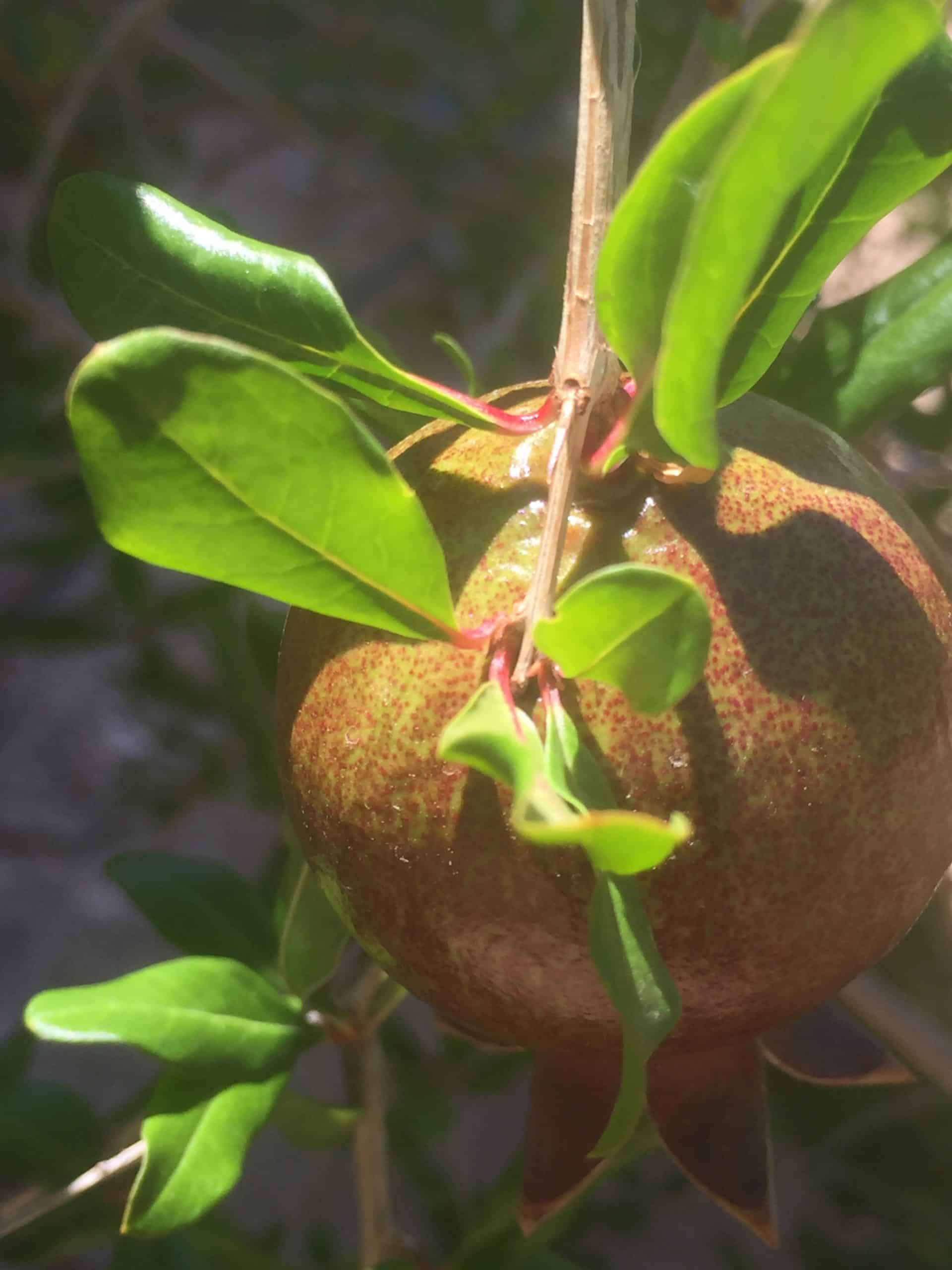A pomegranate tree or shrub is a good choice if you want a fruit-bearing tree. They are suitable for beginner gardeners. Pomegranate trees are ideal first trees to start a small orchard.
Growing a pomegranate tree can yield mighty pomegranates in your backyard. They also grow well in container gardens and indoors. It’s a pretty tree with colorful blooms. These deciduous shrubs are easy to care for, drought tolerant, and typically unaffected by pests and disease.
It can be expensive buying fruit trees. Take a few minutes to learn what’s involved. Pomegranates are easy to grow but you need to go about it the right way.
Here I explain what you need to know to get started planting and growing pomegranate trees to yield a bountiful harvest. I own three pomegranate trees.
Where Do Pomegranate Trees Grow Best
USDA Plant Hardiness Zones 7 to 10 are the ideal climates for growing pomegranate trees. You can grow pomegranate trees in partial shade, but it’s best to expose them to as much sun and heat as possible.
They tolerate heat and drought well and thrive in climates where the temperature is above 85°F for at least 120 days a year.
Despite being drought-resistant, pomegranate trees sometimes need supplemental irrigation during extended periods of drought. Otherwise, they won’t produce fruit, and young trees are likely to experience substantial damage.
So while I live in gardening zone 9b with hot summers and monsoons, sometimes it’s a dry summer. This is when I need to water them myself.
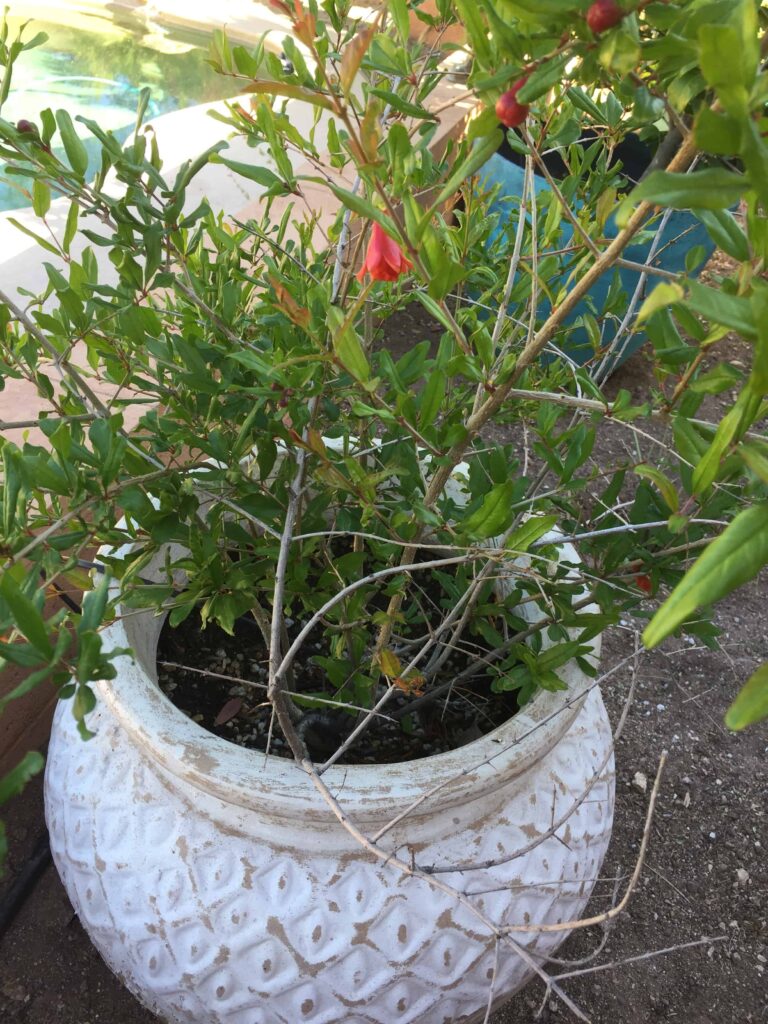
Most pomegranate varieties are hardy in temperatures as low as 12°F, and the hardiest can survive without damage in temperatures as low as 0 – 7°F. The trees are most cold-resistant during the winter months and most vulnerable to frost damage before reaching full dormancy.
You can also grow them indoors as a productive houseplant. Choose a window with full sun.
How Many Pomegranate Trees to Plant
Pomegranate trees are self-fertile. This means you only need to have one in order for it to produce fruit. However, growing two or more will increase your yield.
You have several options for growing pomegranates. You can grow from:
- Mature pomegranate trees
- Saplings, seedlings, rooted plugs
- From seed
How Much Do Pomegranate Trees Cost
A tree in a 3 gallon container will cost around $65 – $75 from a nursery and $35 – $45 from a home improvement store such as Home Depot or Lowes. You will be able to buy larger trees for $99 or more.
If you go to the store during the spring, you will find many of the established trees already have blooms and pomegranate fruit already developing on them.
Where to Buy Pomegranate Trees
Depending on where you live, you may be able to find pomegranate trees for sale in your area at a nursery or garden center. Like all fruit-bearing trees, buying pomegranate trees is expensive.
I recommend buying from a nursery if your budget allows. There you can get expert advice on where to plant it to maximize its growth potential. They can also share their knowledge about the best soil to grow it in if you are planting it in the ground versus in a pot.
If you live in USDA hardiness zones 7 – 10, you should be able to find a pomegranate tree near you. These are areas in which pomegranates can grow outdoors year round.
Check with your city, town, or village. In areas where pomegranates thrive, they may offer them as part of their tree-growing and shade programs where you can buy them for a discount. (My electric company sells them for $5 each in a 5 gallon container!)
Buying a Mature Pomegranate Tree
While pomegranate trees are fast-growing trees, it will yield fruit faster from an established tree than if grown from seed. If you have access and the money to buy a mature pomegranate tree, I highly recommend buying one that’s mature.
You can plant the established tree directly in the ground or in a larger container on your patio or in your yard. You can also grow it indoors.
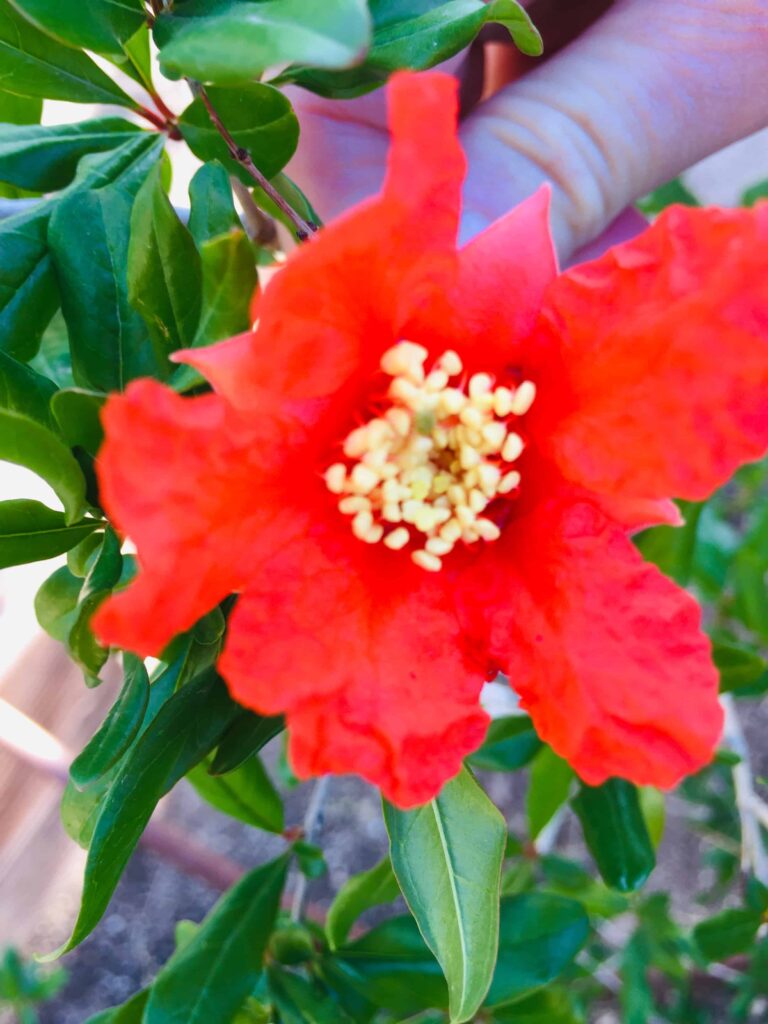
Starter Tree, Sapling, Rooted Plug
If you live in a climate where you won’t find a local pomegranate tree for sale near you, an option is to purchase a starter tree. You can find pomegranate trees online as saplings or seedlings as live plants.
These starter trees have started growing but won’t have flowers or fruit. They will be much smaller than you’ll find in stores. Some may be as small as 3 – 4 inches in height up to 8 – 10 inches.
Growers will sell them different ways. They may sell them in one gallon grow bags or in small pots that are 4 – 8 inches in diameter. Sometimes the trees are smaller and will wrapped as rooted plugs.
Ordering online will be a good option for you to grow a pomegranate tree even if you don’t live in growing zones 7, 8, 9 or 10. You can grow pomegranate indoors as a houseplant. You may choose to keep it outdoors in the spring and summer and indoors in the winter or keep it indoors year round.
However, if you live in a temperate growing zone, you can plant the sapling directly in ground or transplant to a larger container to grow outdoors.
Growing Pomegranate from Seed
I highly recommend you start with a starter plant instead of planting from seed. It will take extra time to establish and grow fruits. However, another option is to grow pomegranate from seed.
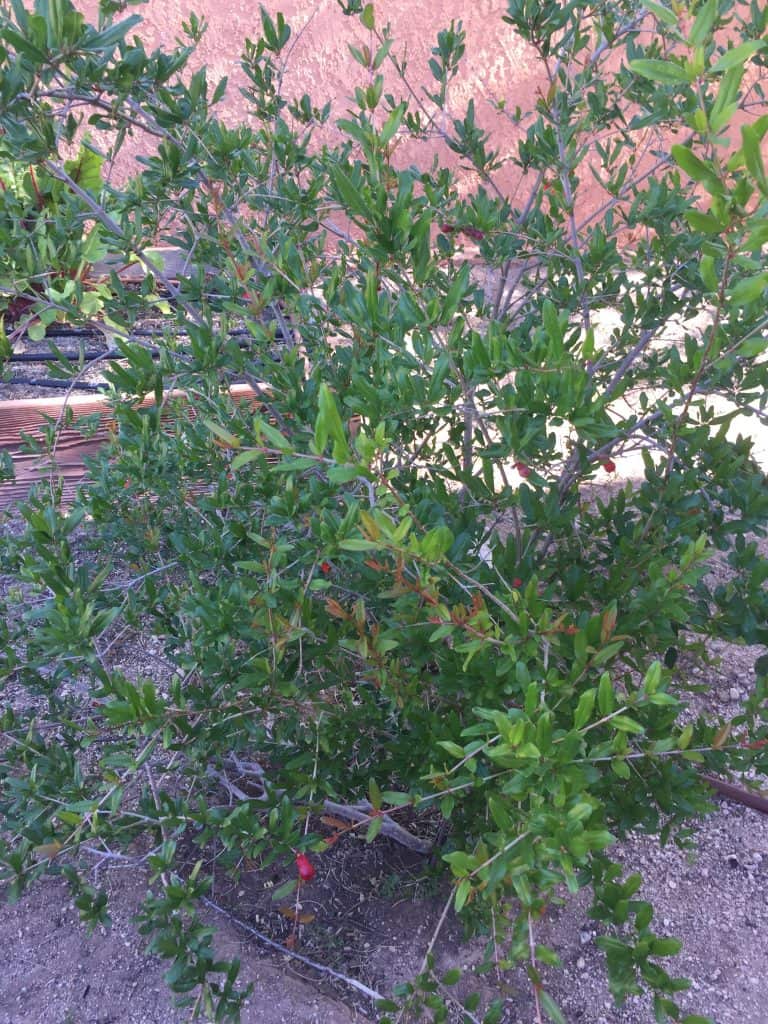
How to Grow a Pomegranate Tree
There are several important factors to be successful growing pomegranates. Warmth is critical to the growth of pomegranate trees. They flourish in dry arid climates such as Arizona and California.
Growing in the Ground
If growing pomegranate in the ground, you’ll use native soil mixed with well-drained loose soil. While pomegranates thrive in various types of soil, including sandy and heavy clay, loamy soil is the best type for growing these trees.
Be sure to keep the root ball intact when transplanting into the ground.
Pomegranates grow best in temperate climates as well as tropical and arid and semi-arid regions. We live in zone 9b, and pomegranates do very well because we have hot and dry summers and cool winters.
Like citrus trees, they can withstand temperatures of 100 degrees F and higher. Because they do so well all types of soil, this is a good way to start a garden in an area with poor soil. This is a good tree to grow directly into the ground.
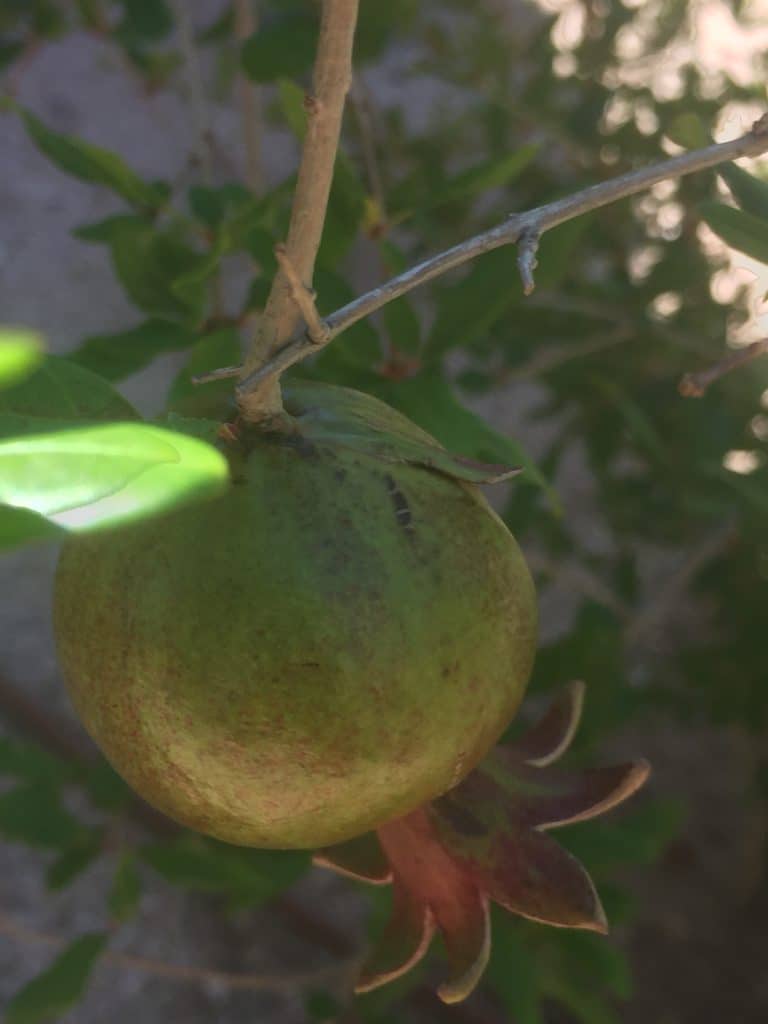
Growing in a Container
When planting in a container, the growing conditions, including soil type, make all the difference.
Choose a large pot with drainage holes. You’ll want to be sure the roots do not sit in water or they will rot. Root rot can kill the tree. If possible, move the pot around so the ground has a chance to dry out underneath.
If growing in a container, nutrient-rich soil is essential. This is where the tree roots will access their nutrition. Use the best quality soil you can afford and have access to. Remember the root ball will also take up some room in the container. Quality soil is expensive but a one-time purchase for the most part.
The soil should include compost and be well-draining and loose. Loamy soil — comprised of sand, clay, and silt — is best.
Pomegranates do well with soil that is neutral-to-slightly acidic. Ideally, the pH should be 5.5 – 7 though they can also grow in moderately alkaline soil.
Growing in a container means the only other nutrients the tree will receive is from fertilizer. This means, use the best soil you can.
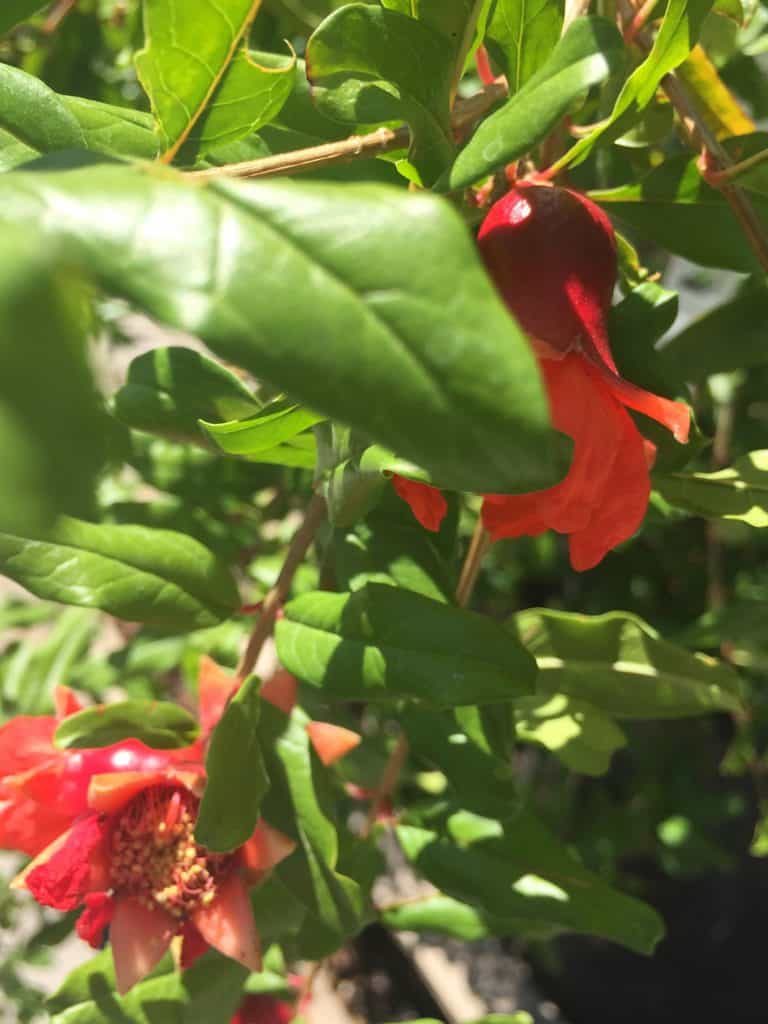
Location
Choosing the right location is key. The great news is their roots aren’t invasive. This means you can plant them next to your home, garage, fence, driveway, etc. without worrying. Their lifespan is 95 – 100 years or longer.
You’ll need to factor in a few things before deciding where to plant the pomegranate tree. Consider:
- Sunlight
- Ease of watering
- Predators and pests
- Frost and cold protection
Sunlight
Being this is a fruit-producing tree, you’ll want to ensure to plant the pomegranate in a sunny location. They require full sun. At a minimum it should have six hours of direct sunlight each day.
Morning and early afternoon sun is best if you live in a climate with hot summers. However, pomegranates will thrive in late afternoon sun as well, especially as it becomes more established.
Pests
Depending on the season and their access to water, deer may or may not eat the leaves and the fruits. Javelina and packrats will eat them. Birds and squirrels will eat the fruits.
Bear this in mind when choosing a location to plant the trees. We have our pomegranate trees inside our walled backyard. This keeps them a little more protected than if they were out in the rest of our acreage which is open. It really depends what critters you have on your property.
Frost and Cold Protection
If you expect a cold evening with a chance of frost or a late frost, be sure to cover the pomegranate shrub with a frost cloth or other blanket.
Before they reach full dormancy, pomegranate tree bark is especially vulnerable to frost damage. This damage usually happens on the south side of the tree closest to the ground. Painting the bark with flat latex paint to minimize day and night temperature fluctuations is one way to prevent frost damage.
Ease of Watering
While pomegranate trees are able to withstand droughts, it’s imperative to water them in the hot months of scalding sun. Choose a location that will be convenient for you to water them weekly. However, they can survive missed waterings. This makes them ideal if you travel.
If you set it up on irrigation, this won’t be an issue.
They are moderately tolerant of flooding.
Pomegranate Tree Care
When it comes to caring for your pomegranate tree, know that once you’ve planted it, it’s fairly low maintenance. They are reliable trees that will grow and produce fruit as they age.
Pomegranate trees do not require a lot of upkeep, but there are things you can do to ensure they thrive. They need relatively little water, and they can survive drought conditions. Excess water from heavy rain and high humidity can cause their fruit to crack and decrease fruit production.
They will need consistent care but it will be easy. Basically, there is:
- Watering
- Mulching – may not be necessary
- Fertilizer – may not be necessary
- Checking for pests
- Pruning and trimming
How Often to Water Pomegranate Tree
You’ll need to water weekly during the hot months. Water the tree deeply once a week. Consider monsoons and rainfall as well and adjust accordingly. Do not water in the wet season.
If you miss watering, it is okay as this tree is hardy.
When watering, take special care to ensure the trunk does not get wet. You can do this by drawing a ring around the plant. If growing in the ground, draw it as far out as the spread of the branches are. If growing in a pot, draw the ring as far out as you can. Draw a ring by gently pressing down in the soil in a circle around the tree.
Water slowly within the ring so the water seeps into the soil to the roots. It’s also important to water slowly so the water doesn’t gush over to the trunk.
Again, when growing in a pot, be sure there are plenty of drainage holes. If you buy the pomegranate tree at a nursery, you can ask them to recommend a planter for it.
You don’t want the soil to remain soggy. A simple moisture meter can help. Or you can stick your finger in the soil to about three inches down. If it’s dry, water it. In the colder months, water sparingly. Once a month or less may be sufficient, especially if there is rain.
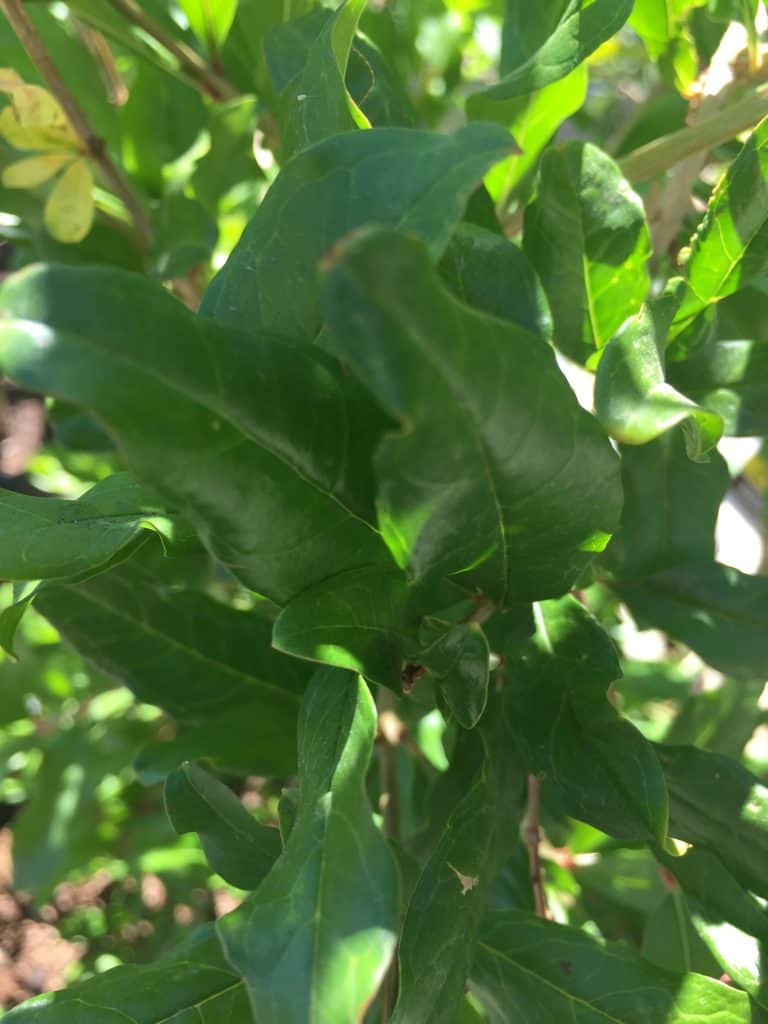
Mulch
Take special care to keep mulch away from the tree trunk. You can add mulch to help retain moisture, however, it’s not necessary. If you are growing in a pot, there is no need to mulch these trees.
Fertilizer
When it comes to pomegranate care, fertilizer isn’t always necessary. If the shrub isn’t growing well or isn’t fruiting, you can apply 8-8-8 fertilizer twice a year, in March and November. However, don’t fertilize the first year.
Overfertilizing can reduce the number of fruits that grow and can delay their maturity. It can also impact their color. Give young trees between 2 – 2.5 lbs and mature trees 4.5 – 6.5 lbs.
Choose organic fertilizer when growing fruit. However, if your tree is doing well and producing flowers, blooms and fruit, you may want to skip fertilizing it.
Pests and Disease
It’s important to check the tree for pests and fungal diseases. When possible, at least once a week, check the leaves, soil and trunk for any signs of distress.
- Omnivorous leafroller, aphids, and citrus flat mite can affect a pomegranate bush.
- When it’s producing fruit, you’ll want to be sure critters such as squirrels and birds aren’t getting to the fruit before you harvest it.
- Also check for root rot.
Pruning a Pomegranate Tree
Pomegranate trees don’t need pruning. However, you may want to prune your tree for size and to produce a shapelier tree. Pruning may also help with harvest and producing better fruit. Prune your pomegranate tree in late winter after it has lost all of its leaves.
In their dwarf varieties, pomegranate trees grow as low as two feet high. Since pomegranate trees are relatively small, they can thrive in pots and other garden containers.
Depending on the variety and the conditions, they can grow to 3 – 6 feet tall and up to 33 feet tall (10m). Many varieties grow more like bushes.
If growing outdoors in the ground in a backyard orchard or garden, you won’t need to prune them. Just remove any dead or damaged branches.
If growing in a container, you may need to prune the pomegranate. It depends on how large the pot or container is.
If you are growing indoors, you’ll want to prune yearly to keep it small. Be sure to leave two or three shoots per scaffold branch.
Pomegranate trees are known for producing suckers, and it’s best to prune them as they sprout.
How to Prune Pomegranate Tree
- Do not prune the first year
- Prune after the tree is at least two feet tall
- Wait until the threat of frost has passed to remove broken or dead branches
- Prune before new growth begins
- It’s okay to remove the branches or leaves lower (close to the ground) at any time
Tips for Pruning
- Let the tree develop four to five shoots approximately one inch above the ground
- Encourage shoot development by shortening branches during the tree’s first three years
- When the tree is three years old, prune away diseased, damaged, and dead branches
It’s essential to not prune in late summer, fall, or winter. You don’t want to remove any flowers that will fruit.
Harvesting Pomegranates
How long does it take pomegranates to bear fruit depends if you start with a mature tree or plant from a seedling or seed. Most varieties you buy from a nursery or online garden center will produce fruit within three years.
In general, the more expensive the tree, the larger and more established it will be. This means purchasing a larger 5 gallon tree versus a smaller tree in a one gallon container, the faster you will enjoy fruits.
You can purchase some pomegranate trees and have fruits that same year. The Wonderful variety grows quickly and can grow fruits the first year if you buy an established tree.
The fruits will start growing months before they are ready to harvest. Typically, the fruits will be ripe and sweet in August through October. They won’t all become ripe at the same time which means you can enjoy picking and eating them for weeks and sometimes months.
It is important to know when to harvest pomegranates because you want to be sure they are sweet.
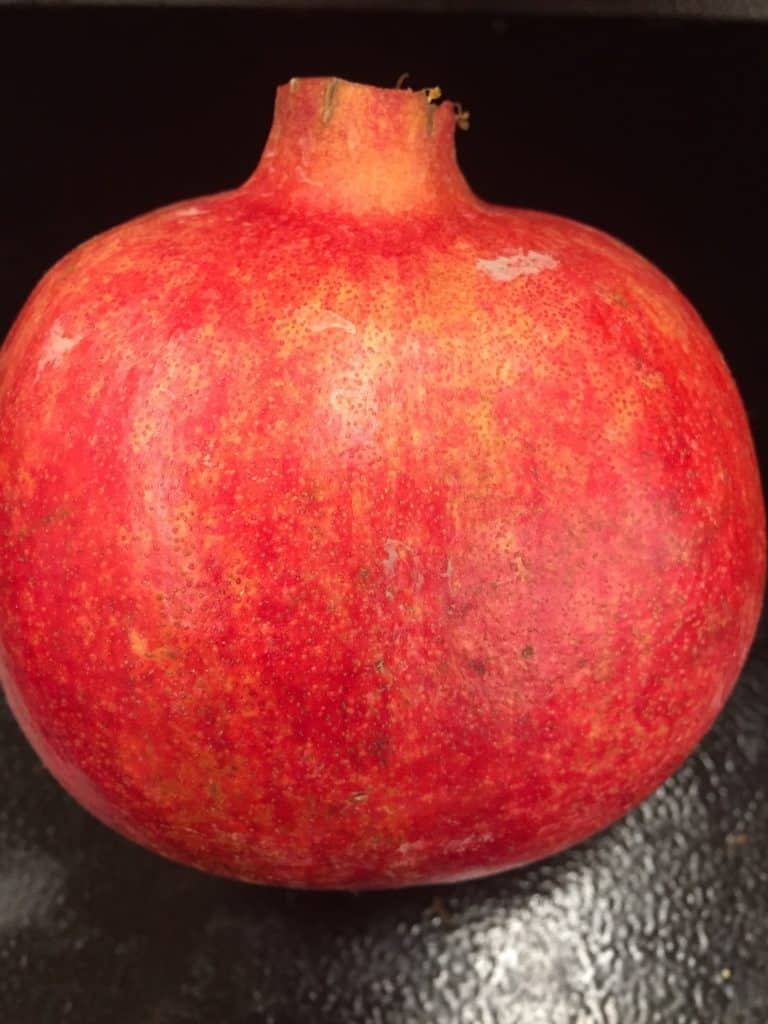
How to Tell if a Pomegranate Is Ripe
It takes a good 6 – 7 months from the time your pomegranate trees bloom to the time you will be able to harvest pomegranates. A lot will depend on your climate, the weather, and the variety you are growing.
You don’t want to pick pomegranates until they are mature. They will not ripen off the tree. However, already-ripe pomegranates will ripen further and eventually spoil after they are picked from the tree.
Only pick pomegranates that are red, reddish-brown, or pinkish red. It will depend on the variety. You do not want to pick green pomegranates as they are not ripe yet.
Learn how to tell if a pomegranate is ripe. In addition to the fruit size, look for a square shape instead of a round or oval shape. It should not be perfectly round. The bottom should be flattened as should the top where the stem is. If the fruit is perfectly round, do not pick it yet. Wait for it to have a more square appearance.
Another tip is to gently cup the bottom of a pomegranate while it’s hanging from the tree. If it feels heavy for it’s size and is red, not green, it may be ready to pick.
Pick one, bring it inside, wash it, cut it open, and taste the arils. If it’s not ready, wait before picking others and wait for it to look more boxy.
Splitting or Cracking
If you have any pomegranates that are splitting open or are cracking, pick them and eat them soon. They are already ripe. You don’t want ants getting to them. You don’t want them to spoil. Harvest them, and put them in the fridge.
To harvest pomegranates, cup the bottom of the fruit with one hand which holding the stem with the other. Gently twist and pull to release the fruit. You can also use scissors to gently remove them.
In time, you can have an abundant harvest with two or more established trees, totaling over 100 pounds of fruit. Again remember: Only pick ripe fruit. They will not ripen off the tree.
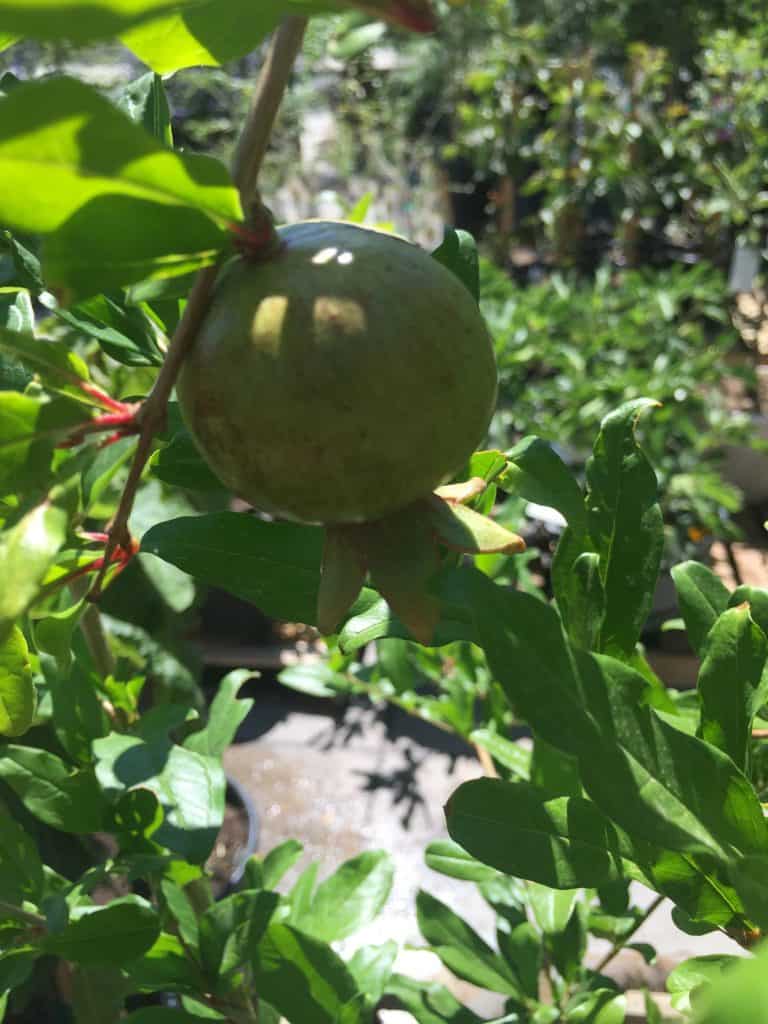
How Do Pomegranate Trees Pollinate?
Pomegranate trees can self-pollinate, or insects can pollinate them. That means you only need one pomegranate tree to produce fruit. However, growing more will greatly increase the yield.
Hummingbirds, bees, and other insects do most pomegranate pollination because there is little wind dispersal of the pollen. If your pomegranate tree isn’t producing fruit, a lack of pollinators may be to blame.
Pomegranate trees begin to bloom in April and continue to bloom through June. Depending on the variety, they may bloom continuously or in three to four flushes. Although pomegranate trees primarily bloom and yield the largest fruit in the early spring, they often produce flowers well into the fall months.
If your pomegranate trees aren’t producing fruit, you can remedy the problem through hand-pollination or attracting more pollinators to your garden. Hand-pollination is a straightforward process that requires using a cotton swab or paintbrush to transfer pollen from the male stamen to the female ovary.
If you have multiple pomegranate trees, you cross-pollinate by going from tree to tree, which will increase the crop.
A second option is attracting more pollinators to your pomegranate tree by installing a bee house with larvae or a birdbath or fountain. A final option is planting wildflowers with blooms that will lure insects to your garden to help pollinate your pomegranate trees.
Pomegranate Tree Varieties
When we speak of pomegranate trees, we’re not speaking of just one homogeneous tree. Pomegranate trees are a diverse species with many cultivars.
Here are the most popular pomegranate varieties. Choose from these cultivars which are easy to grow. While there is a difference between pomegranates and their taste and appearance, it’s important to get one that’s suited to your climate.
Sweet
An early-ripening cultivar, this variety produces earlier in the season. It is fast growing. This pomegranate tree growing zone is 7 – 10.
Punica (aka Wonderful)
Wonderful is known for its tangy purple-red fruit. If you’ve eaten a commercially produced pomegranate, it was most likely the Wonderful variety. They are an excellent choice for fruit and cold hardy to zones 8 – 11.
A Wonderful pomegranate tree can produce 100 or more fruits a season. They are easy to grow and the most popular cultivar for home gardens. These trees grow quickly and can bear fruit the first year.
You will likely see a brand called Pom Wonderful which sells pomegranates in the late fall and winter months in the United States.
Russian Red
This is a very cold hardy cultivar. Produces fruit in 2 – 3 years. Hardy outdoors in zones 6 – 9. It grows quickly.
Salavatski Russian / Russian-Turk
This cold hardy variant can withstand colder weather down to 0 degrees F. It’s ideal for growing zones 7 and 8. It’s also heat tolerant. Bears fruit August – October.
Eversweet
Grows well outdoors in zones 7 – 10. It’s drought tolerant with a moderate growth rate. Eversweet fruits are tasty even they are immature. It produces gorgeous orange and red blooms.
Red Silk
Slow growing tree but can produce fruits in as little as 1 – 2 years. It grows well outdoors in climate zones 7 – 10.
Utah Sweet Pomegranate
The seeds produced by this pomegranate are notably softer than the wonderful and other varieties. It’s a small shrub tree with attractive pink-orange flowers.
Nana
Cold hardy for colder climates. It’s ideal for growing in zone 7.
Dwarf Varieties
A compact version of the pomegranate tree, this version matures at 2 to 4 feet high. They produce fruit and have red-orange flowers. They are ideal for containers and to grow indoors. To keep it small indoors, plant in a one gallon pot instead of a larger one. The smaller the container, the smaller it will likely grow.
Other names for pomegranates are grenadines or Chinese apples. Their scientific name is Punica granatum.
Lifespan
Pomegranate trees can live over 100 years and can continue producing fruit during its lifetime. However, the average tree only produces fruit during the first 12 – 15 years. A native of Persia, they are among the oldest cultivated fruits. Literary references to pomegranates date as far back as the Old Testament and beyond.
It’s also a pretty tree with its colorful blooms. Pomegranate fruits are recognizable for their leathery, smooth skin and vibrant colors, ranging from lemony yellow to dark red.
Fruit Bearing vs Ornamental Pomegranates
Fruit-bearing pomegranates are often too large to grow in small areas such as a doorway, flanking a sidewalk, or a garden entrance. Ornamental pomegranates are an excellent option if you don’t want a pomegranate tree that produces fruit.
Ornamental pomegranates are smaller than traditional pomegranates and have striking blossoms in various colors.
Final Thoughts
You don’t need to have an orchard to grow pomegranate shrubs and trees. Growing trees that produce fruit is a way to provide food for your family and begin homesteading by being sustainable.
You can start with a few in pots on your patio and “grow” from there.
These trees do best in warmer climates and need a lot of sun to thrive. They do indoors in all climate zones and outdoors in zones 7 – 10. If you choose the right variety, you can also grow them in zone 6 and 11.
Well-drained soil is important to successfully grow these trees. Saturated soil damages the roots. If growing in a container, select a pot with good drainage to ensure the tree stays healthy.
Growing a pomegranate tree is an excellent choice for anyone looking for an attractive tree with red and orange blooms. It doesn’t require a great deal of upkeep and it produces fruits. It’s a great addition to home gardens.
Expand your orchard with these fruits:
Resources:

